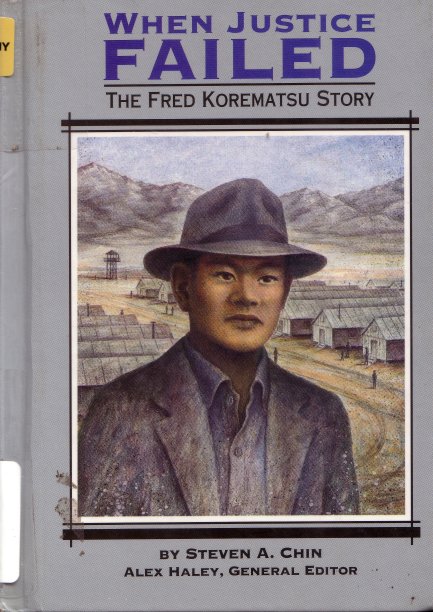
When Justice Failed: The Fred Korematsu Story

Steven A. Chin, 1993
This children's books describes Fred Korematsu's upbringing as a young child. His actual name was Toyosaburo Korematsu, and the book tells an interesting story how he got the name "Fred."
After he was grown-up he was working as a welder at a shipyard making merchant ships. Although he was a member of the union he ended up being fired without any reason being given. He got another job and was also fired from that one, this time the boss being plain and telling him he was fired because he was Japanese.
This was all before Pearl Harbor.
Fred had a white girlfriend whose parents didn't approve of their relationship. After the bombing of Pearl Harbor came FBI hunts and the posting of notices stating a curfew existed for all Issei and Nisei. Then soon after came the notice that they were all going to be rounded up and moved away. This would have separated him and his girlfriend.
So Fred moved out of the house and into a boarding house. He changed the name on his draft card and managed to get another welding job. He ended up being caught, though, and was arrested for avoiding the evacuation. Ernest Besig was a lawyer working for the ACLU who decided to take Fred's case.
Besig wanted Fred to be a "test case" to challenge the discrimination against the Japanese Americans and Fred agreed. The ACLU itself didn't want to handle the case, but Besig got a Fred a lawyer for the trial. Besig paid $5000 to get Fred free awaiting trial but Fred no sooner left the building then he was picked up by military police.
He was taken to the Tanforan assembly center. At the trial Fred is found guilty, but instead of being sentenced to prison he's give five years probation and is taken back to Tanforan. From there he was shipped to Topaz.
An incident at Topaz that I didn't find elsewhere related to a gang of white boys driving past the camp three times, throwing rocks and shooting guns, injuring three inmates. The boys were caught and put in jail.
Fred's case was appealed all the way to the Supreme Court, but he lost. In 1982, after several jobs and a marriage, Fred found out that the government had been hiding information relating to his trial. The documents were basically showing that the reasons given for evacuating the Japanese were not backed up by actual evidence. On November 10, 1983, Fred once again went to trial. Government attorneys tried to stop the trial but were overruled. This time he won the case. He was hoping to prevent anyone else from being treated like he was in the future and he won.
This is a book for young readers and it's written in an entertaining manner, yet it gets across its point quite well. A good examination of the Korematsu case for younger readers.
Main Index
Japan main page
Japanese-American Internment Camps index page
Japan and World War II index page
|